Media Reports on COVID-19 Vaccinations: A Study of Topic Modeling in South Korea
Abstract
1. Introduction
- (Q1) Can we observe any topic changes in media reports on COVID-19 vaccination in Korea across time?
- (Q2) Were the media reports on COVID-19 vaccination in Korea informative to the public? Did the legacy media outlets in Korea focus on the topics directly related to COVID-19 vaccination or become distracted with other topics rather than public health?
2. Materials and Methods
2.1. Study Period
2.2. Data Collection
2.3. Data Processing
3. Results
3.1. Phase 1 (18 May 2020–17 December 2020)
3.2. Phase 2 (18 December 2020–25 February 2021)
3.3. Phase 3 (26 February 2021–31 March 2021)
3.4. Phase 4 (1 April 2021–25 September 2021)
4. Discussion
5. Conclusions
Author Contributions
Funding
Conflicts of Interest
References
- Khan, S.; Siddique, R.; Shereen, M.A.; Ali, A.; Liu, J.; Bai, Q.; Bashir, N.; Xue, M. Emergence of a novel coronavirus, severe acute respiratory syndrome coronavirus 2: Biology and therapeutic options. J. Clin. Microbiol. 2020, 58, e00187-20. [Google Scholar] [CrossRef] [PubMed]
- Malik, A.A.; McFadden, S.M.; Elharake, J.; Omer, S.B. Determinants of COVID-19 vaccine acceptance in the U.S. eClinicalMedicine 2020, 26, 100495. [Google Scholar] [CrossRef] [PubMed]
- Nikolenko, S.I.; Koltcov, S.; Koltsova, O. Topic modelling for qualitative studies. J. Inf. Sci. 2017, 43, 88–102. [Google Scholar] [CrossRef]
- Jelodar, H.; Wang, Y.; Yuan, C.; Feng, X.; Jiang, X.; Li, Y.; Zhao, L. Latent Dirichlet Allocation (LDA) and Topic modeling: Models, applications, a survey. Multimed. Tools Appl. 2018, 78, 15169–15211. [Google Scholar] [CrossRef]
- Blei, D.M.; Ng, A.Y.; Jordan, M.I. Latent Dirichlet Allocation. J. Mach. Learn. Res. 2003, 3, 993–1022. [Google Scholar]
- Maier, D.; Waldherr, A.; Miltner, P.; Wiedemann, G.; Niekler, A.; Keinert, A.; Pfetsch, B.; Heyer, G.; Reber, U.; Häussler, T.; et al. Applying LDA topic modeling in communication research: Toward a valid and reliable methodology. Commun. Methods Meas. 2018, 12, 93–118. [Google Scholar] [CrossRef]
- Carnot, M.L.; Bernardino, J.; Laranjeiro, N.; Oliveira, H.G. Applying Text Analytics for Studying Research Trends in Dependability. Entropy 2020, 22, 1303. [Google Scholar] [CrossRef] [PubMed]
- Rohani, V.A.; Shayaa, S.; Babanejaddehaki, G. Topic modeling for social media content: A practical approach. In Proceedings of the International Conference on Computer and Information Sciences (ICCOINS), Kuala Lumpur, Malaysia, 15–17 August 2016; pp. 397–402. [Google Scholar]
- Pooja, K.; Bansal, P. Topic Modeling: A Comprehensive Review. EAI Endorsed Trans. Scalable Inf. Syst. 2019, 7, e2. [Google Scholar] [CrossRef]
- Asmussen, C.B.; Møller, C. Smart literature review: A practical topic modeling approach to exploratory literature review. J. Big Data 2019, 6, 1–18. [Google Scholar] [CrossRef]
- Carron, B.; Reynolds, J.; Bennett, K.; Bennett, A.; Griffithsm, K.M. What’s all the talk about? Topic modeling in a mental health internet support group. BMC Psychiatry 2016, 16, 1–12. [Google Scholar] [CrossRef]
- Weng, J.; Lim, E.P.; Jiang, J.; He, Q. Twitterrank: Finding topic sensitive influential twitterers. In Proceedings of the Third ACM International Conference on Web Search & Data Mining; Association for Computing Machinery: New York, NY, USA, 2010; pp. 261–270. [Google Scholar] [CrossRef]
- Mutanga, M.B.; Abayomi, A. Tweeting on covid-19 pandemic in South Africa: Lda-based topic modeling approach. Afr. J. Sci. Technol. Innov. Dev. 2020, 14, 163–172. [Google Scholar] [CrossRef]
- Sharkey, M.; Brown, B.; Baker, A.; Mutanen, M. Response to Zamani et al. (2020): The omission of critical data in the pursuit of ‘revolutionary’ methods to accelerate the description of species. ZooKeys 2021, 1033, 191–201. [Google Scholar] [CrossRef] [PubMed]
- Ghasiya, P.; Okamura, K. Investigating covid-19 news across four nations: A topic modeling and sentiment analysis approach. IEEE Access 2021, 9, 36645–36656. [Google Scholar] [CrossRef] [PubMed]
- Amara, A.; Taieb, M.A.H.; Aouicha, M.B. Multilingual topic modeling for tracking covid-19 trends based on Facebook data analysis. Appl. Intell. 2021, 51, 3052–3073. [Google Scholar] [CrossRef] [PubMed]
- Gallup Korea, Gallup Report on Media, Content, and Social Media. 2021. Available online: https://www.gallup.co.kr/gallupdb/reportContent.asp?seqNo=1205 (accessed on 28 November 2022).
- Lee, S.R.; Choi, E.J. Comparison of responses to issues in SNS and Traditional Media using Text Mining-Focusing on the Termination of Korea-Japan General Security of Military Information Agreement(GSOMIA). J. Digit. Converg. 2020, 18, 277–284. [Google Scholar] [CrossRef]
- Press Industry Number of Businesses and Workers (Korea Press Foundation). Available online: https://www.data.go.kr/data/3034120/fileData.do#/tab-layer-openapi (accessed on 28 November 2022).
- Distribution of Media Industry Businesses by Region (Korea Press Foundation). Available online: http://hannun.or.kr/2021/1-4/ (accessed on 28 November 2022).
- Korea Press Foundation, Media Users in Korea. 2021. Available online: https://www.kpf.or.kr/synap/skin/doc.html?fn=1642385587151.pdf&rs=/synap/result/research/ (accessed on 28 November 2022).
- Wu, X. Routledge Handbook of Public Policy; Araral, E., Fritzen, S., Howlett, M., Ramesh, M., Eds.; Routledge: London, UK, 2015. [Google Scholar]
- Big Kinds Platform. Available online: https://www.bigkinds.or.kr (accessed on 28 November 2022).
- Kim, D.Y. Chosun Ilbo Ranked First in Newspaper Sales Last Year. 2019. Available online: http://www.mediatoday.co.kr/news/articleView.html?idxno=147766 (accessed on 28 November 2022).
- KoNLPy: Korean NLP in Python. Available online: https://konlpy.org (accessed on 28 November 2022).
- Gensim-Python Framework for Vector Space Modeling. Available online: https://radimrehurek.com/gensim (accessed on 28 November 2022).
- Röder, M.; Both, A.; Hinneburg, A. Exploring the space of topic coherence measures. In Proceedings of the Eighth ACM International Conference on Web Search and Data Mining, WSDM ’15; Association for Computing Machinery: New York, NY, USA, 2015; pp. 399–408. [Google Scholar] [CrossRef]
- Supplement: Entire LDA analysis results for phase 1, 2, 3, and 4. Available online: https://icpslab.github.io/supplement_entire_LDA_results.pdf (accessed on 28 November 2022).
- Sievert, C.; Shirley, K. LDAvis: A method for visualizing and interpreting topics. In Proceedings of the Workshop on Interactive Language Learning, Visualization, and Interfaces; Association for Computational Linguistics: Baltimore, MD, USA, 2014. [Google Scholar]
- Noh, S.H. Analysis of issues related to artificial intelligence-based on topic modeling. J. Digit. Converg. 2020, 18, 75–87. [Google Scholar] [CrossRef]
- Google Colaboratory (CoLab). Available online: https://colab.research.google.com (accessed on 28 November 2022).

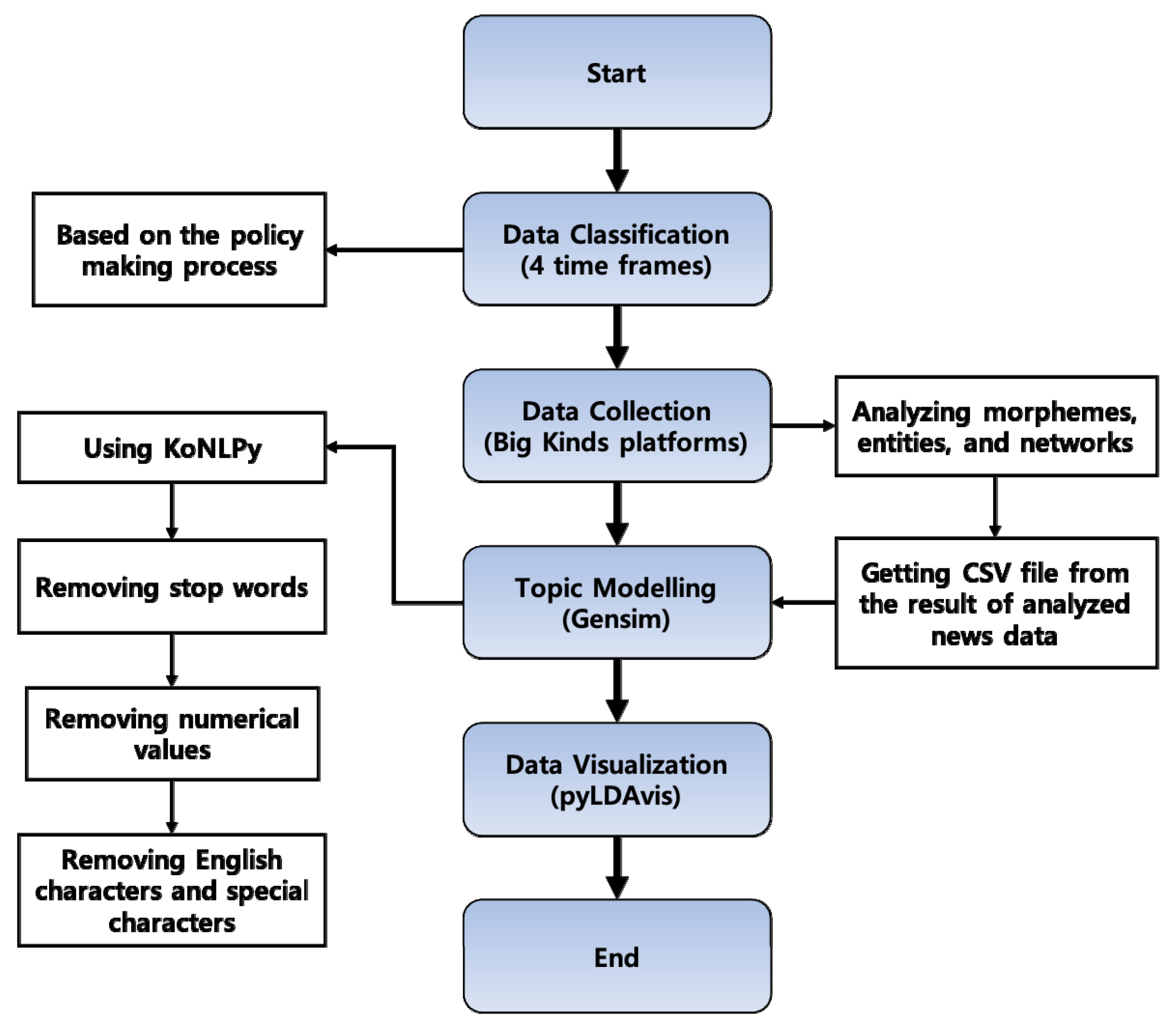
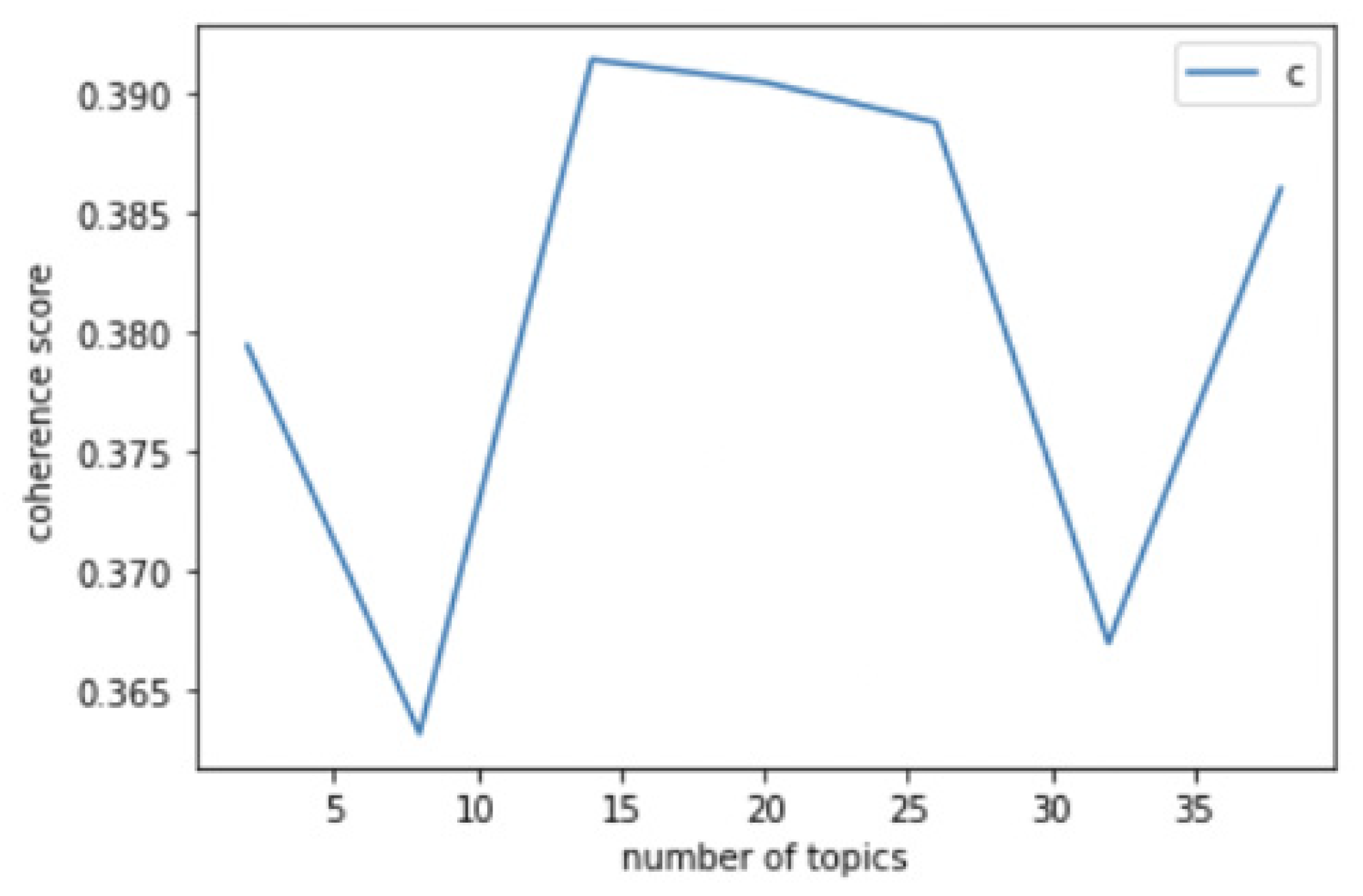
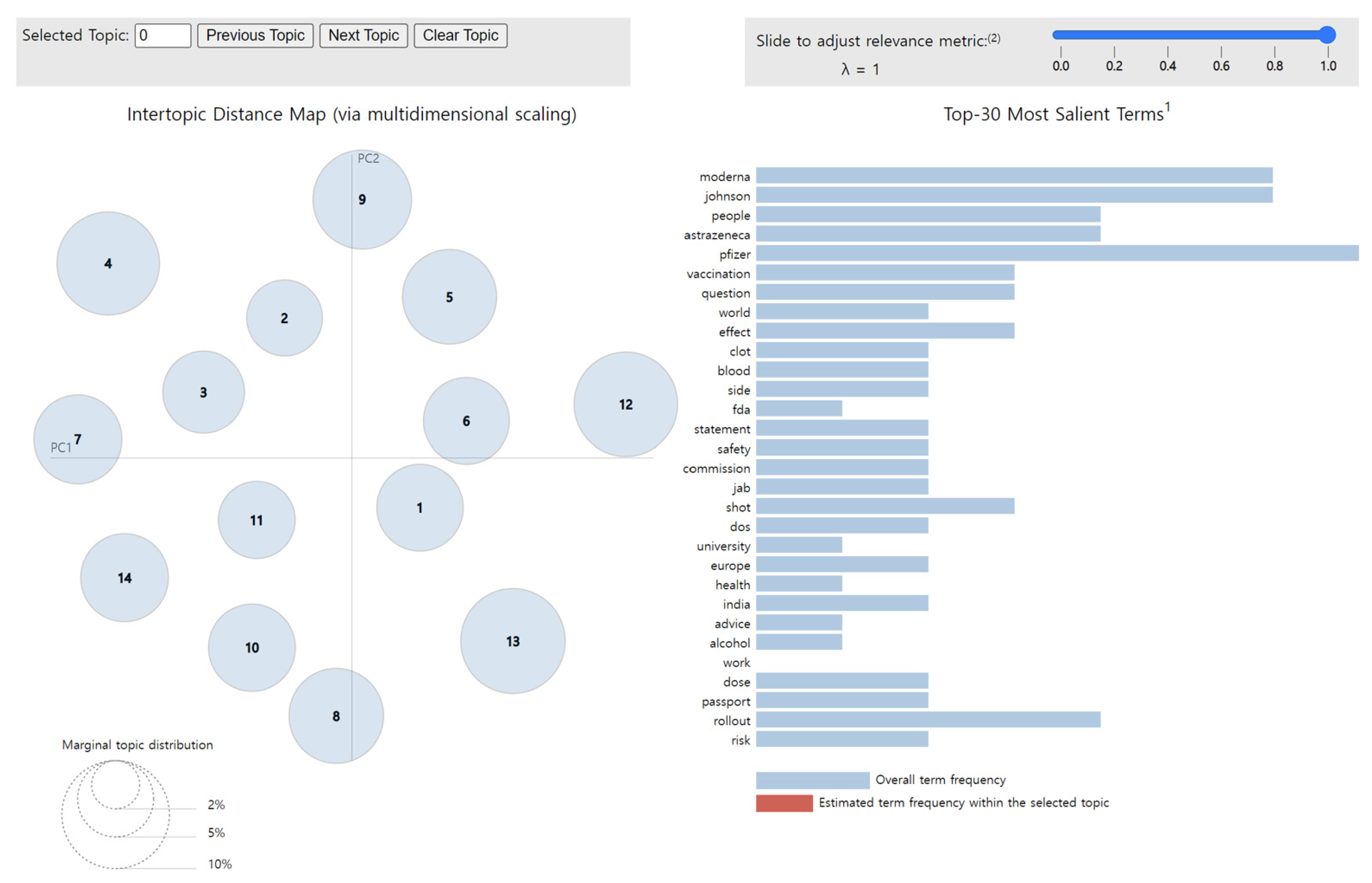
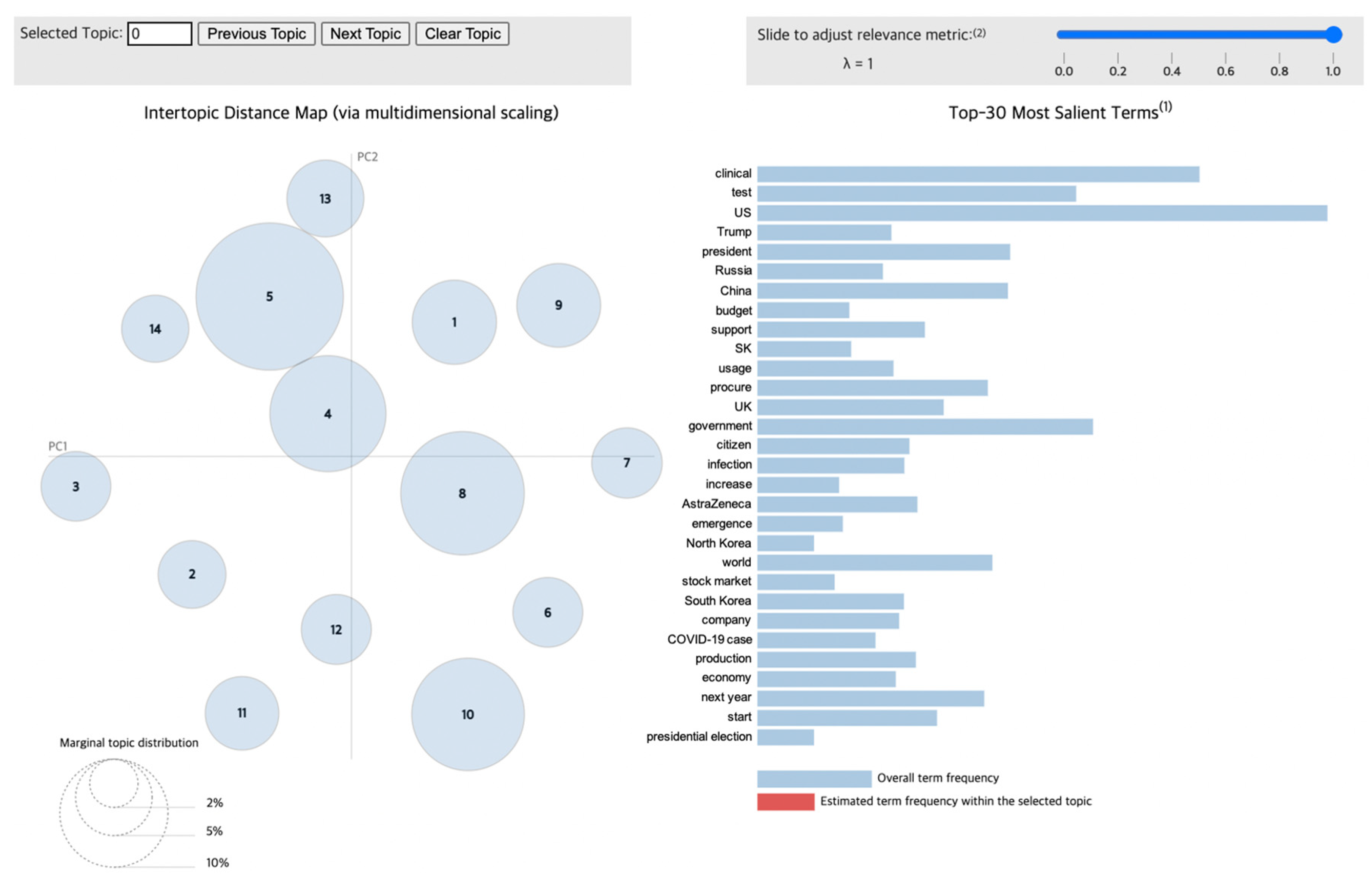
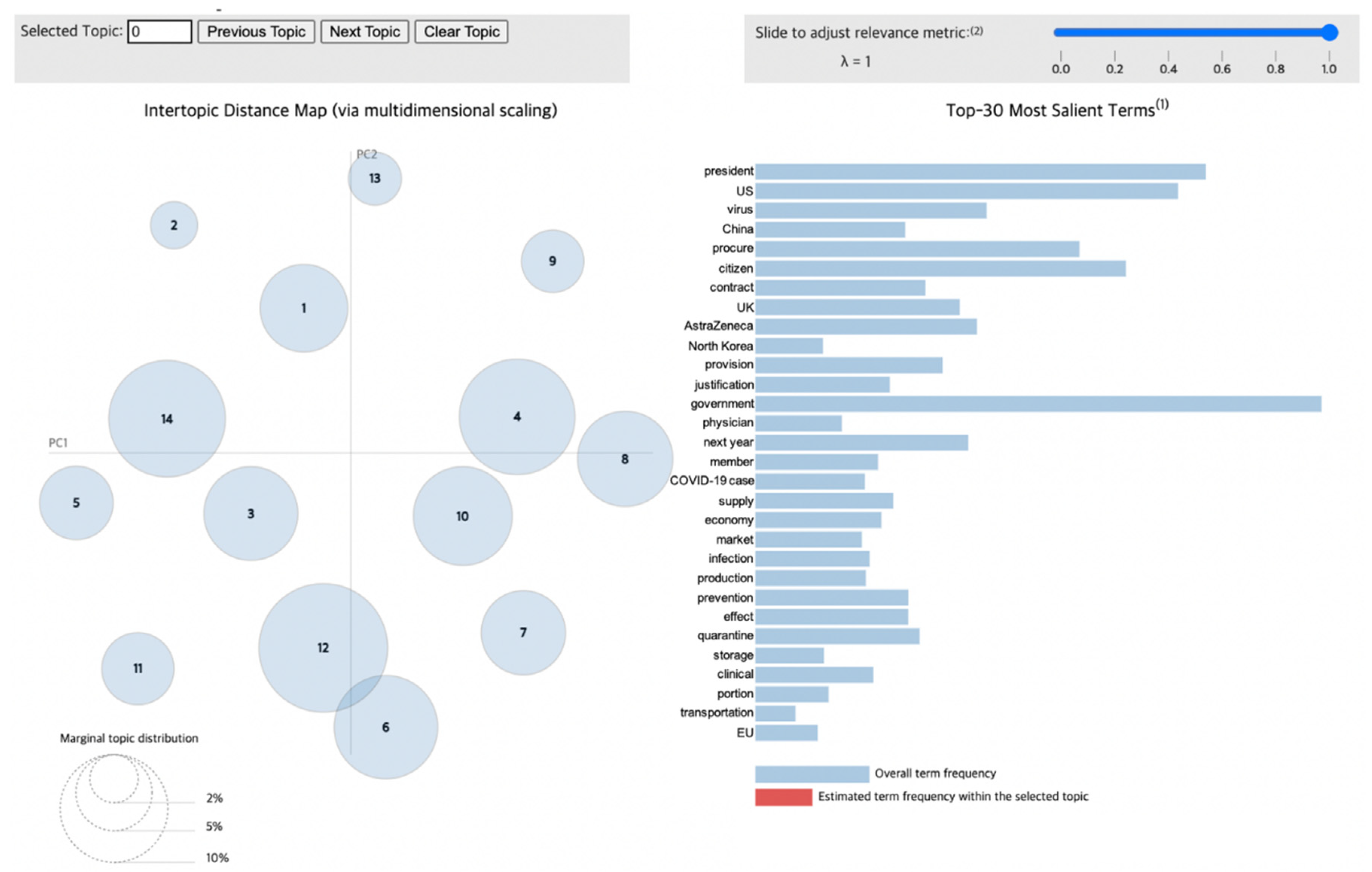

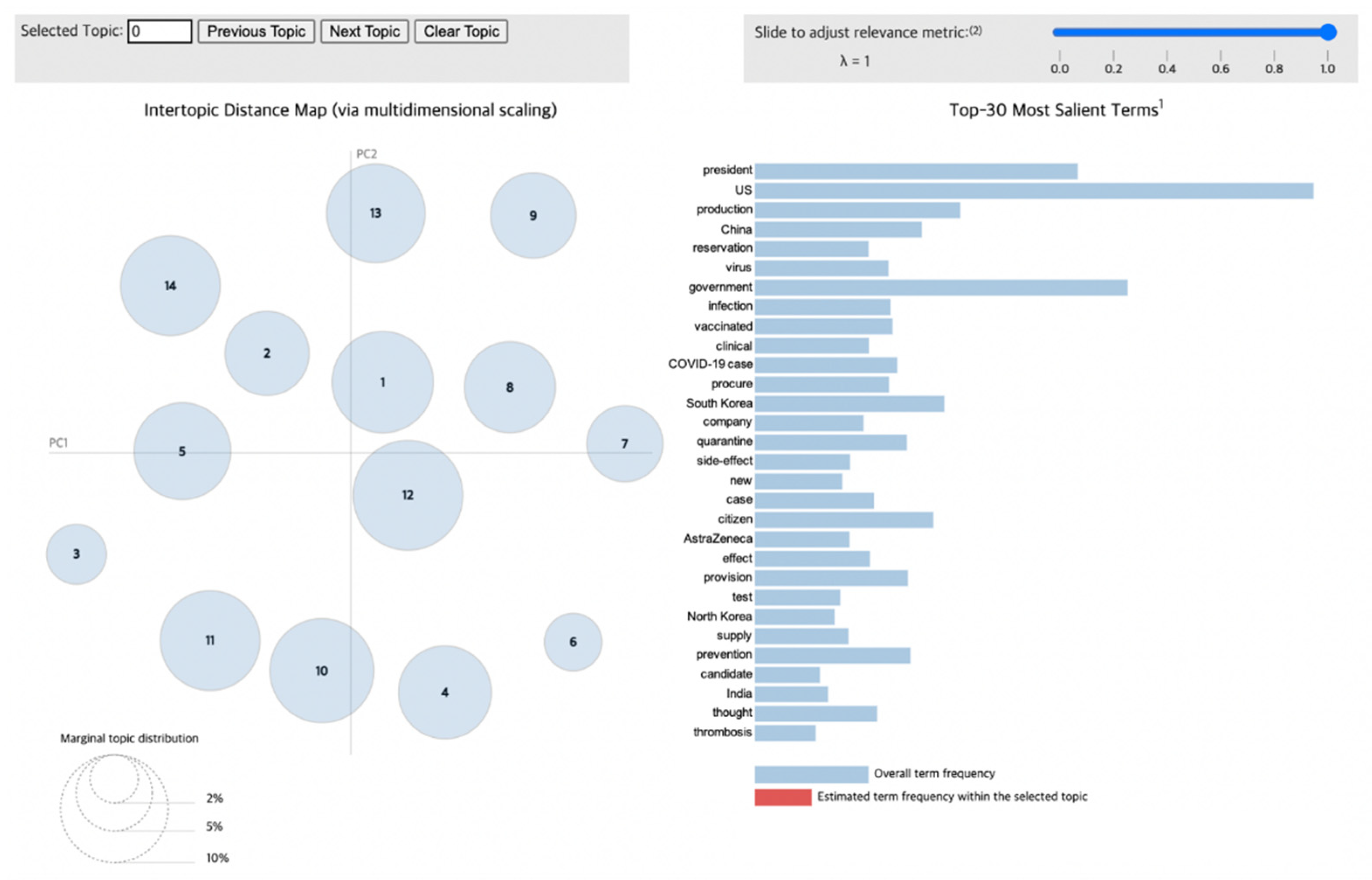
| Phase 1 (18 May 2020–17 December 2020) | Phase 2 (18 December 2020–25 February 2021) | Phase 3 (26 February 2021–31 March 2021) | Phase 4 (1 April 2021–25 September 2021) | ||||
|---|---|---|---|---|---|---|---|
| CSIB * | 703 | CSIB * | 556 | CSIB * | 286 | CSIB * | 1247 |
| DAIB * | 107 | DAIB * | 99 | DAIB * | 66 | DAIB * | 108 |
| HKIB * | 157 | HKIB * | 141 | HKIB * | 51 | HKIB * | 190 |
| HKR * | 76 | HKR * | 66 | HKR * | 27 | HKR * | 100 |
| JAIB * | 309 | JAIB * | 207 | JAIB * | 55 | JAIB * | 306 |
| KED * | 425 | KED * | 273 | KED * | 113 | KED * | 338 |
| KHSM * | 88 | KHSM * | 63 | KHSM * | 17 | KHSM * | 66 |
| KMIB * | 165 | KMIB * | 96 | KMIB * | 51 | KMIB * | 111 |
| MBN * | 234 | MBN * | 151 | MBN * | 46 | MBN * | 196 |
| MHIB * | 50 | MHIB * | 37 | MHIB * | 9 | MHIB * | 44 |
| MT * | 477 | MT * | 253 | MT * | 122 | MT * | 585 |
| SGIB * | 158 | SGIB * | 122 | SGIB * | 63 | SGIB * | 295 |
| SLSM * | 183 | SLSM * | 168 | SLSM * | 64 | SLSM * | 211 |
| KBS ** | 91 | KBS ** | 119 | KBS ** | 46 | KBS ** | 225 |
| MBC ** | 107 | MBC ** | 89 | MBC ** | 37 | MBC ** | 173 |
| SBS ** | 91 | SBS ** | 88 | SBS ** | 33 | SBS ** | 209 |
| YTN ** | 225 | YTN ** | 255 | YTN ** | 90 | YTN ** | 390 |
| Total | 3646 | Total | 2783 | Total | 1176 | Total | 4794 |
| Topic # (Prevalence) | Subject | Words |
|---|---|---|
| 1 (6%) | Global Responses to COVID-19 | world, minister, Japan, UK, economy, summit, response, emphasis, conference, countries |
| 4 (11.5%) | The acquisition and supply of vaccines around the world | China, procure, government, provision, US, contract, purchase, justification, next year, AstraZeneca |
| 5 (18.5%) | Results of the vaccines’ clinical trials | clinical, test, US, result, effect, virus, AstraZeneca, candidate, progress, antibody |
| 6 (4.1%) | Hacking the vaccine distribution network | company, US, economy, hacking, China, information, stock, market, Korea, world |
| 8 (13%) | Status of infection and quarantine | COVID-19 cases, infection, situation, degree, quarantine, level, occurrence, patient, thought, mask |
| 9 (6%) | The development of treatments in Korea | SK, Korea, president, medicine, cooperation, Bill Gates, support, Bioscience, CEO, production |
| 11 (4.6%) | Stabilization of people’s livelihoods in Korea | budget, support, citizen, payment, relief fund, government, national assembly, the budget bill, next year, supplementary |
| 13 (5.1%) | Emergency use of vaccines | US, usage, emergence, start, next year, UK, BioNTech, FDA, food, CDC |
| 14 (3.8%) | The start of vaccination | Russia, Sputnik, world, test, clinical, president, Putin, registration, Brazil, center |
| Topic # (Prevalence) | Subject | Words |
|---|---|---|
| 1 (6.6%) | Production of vaccine | China, production, US, SK, company, shot, Korea, world |
| 2 (1.9%) | North Korea’s attempt and suspicions to hack into treatment information | North Korea, hacking, National Intelligence Service, medicine, Israel, Pope, member, extortion, information, cyber |
| 3 (7.6%) | Vaccination of United States Forces Korea | economy, US army, USFK, world, US, government, Korea, recovery, KATUSA |
| 5 (4.7%) | Initiation and side effects of vaccination | US, Trump, start, allergy, CDC, side-effect, people, reaction, local time |
| 6 (9.2%) | Vaccine clinical trials and results | (λ = 1) virus, UK, effect, clinical, infection, result, test, variant, US, immune |
| (λ = 0.6) virus, UK, effect, mutation, clinical practice, examination, infection, antibody, protein, discovery | ||
| 10 (8.4%) | Status of vaccine acquisition in Korea | government, procure, citizen, quarantine, member, Japan, criticism, situation, comment, president |
| 12 (14.2%) | Sequential vaccination plan in Korea | prevention, government, start, AstraZeneca, plan, subject, medical, work, hospital |
| 13 (2.4%) | Transportation of vaccine | transport, temperature, storage, maintenance, sub-zero, freight, cold chain, distribution, Korean Air |
| 14 (11.7%) | Plan on acquisition and supply of the vaccine | government, procure, contract, provision, next year, AstraZeneca, justification, supply, US, start |
| Topic # (Prevalence) | Subject | Words |
|---|---|---|
| 2 (7.3%) | The international situation | President, US, China, summit, government, Trump, cooperation, minister, Japan, conference |
| 5 (24.7%) | Vaccination and the occurrence of side effects | reaction, AstraZeneca, death, case, hospital, prevention, side-effect, vaccinated, symptom, occurrence |
| 6 (7%) | Adjusting amounts of AstraZeneca in Korea and overseas countries’ interest in vaccine effects for mutant viruses | provision, EU, production, UK, supply, AstraZeneca, government, SK, export, justification |
| 7 (2.8%) | Vaccination and consequent social change | China, Japan, Seocho, passport, border, clinical, Russia, progress, North Korea, issuance |
| 8 (3.8%) | Domestic political issues and vaccine transportation | candidate, transport, mayor, Korean Air, election, president, citizen, thought, Seoul, member |
| 10 (9.3%) | Vaccination and its side effect | US, effect, virus, clinical, result, infection, human, antibody, prevention, test |
| 11 (2%) | Vaccine storage and transportation | storage, temperature, Daegu department store, transport, freezer, refrigerator, keeping, situation, underlying, distribution |
| 14 (4%) | Transportation of vaccine | start, transport, virus, arrival, Genexine, storage, progress, center, immune, ingredient |
| Topic # (Prevalence) | Subject | Words |
|---|---|---|
| 1 (8.8%) | The issue of securing domestic vaccine supplies | government, procure, president, citizen, supply, provision, portion, contract, situation, supply, and demand |
| 2 (6.1%) | Concerns about Infection due to the holidays | Japan, vacation, information, thought, government, people, certification, offer, citizen |
| 7 (5%) | Infection status and clinical trials of the vaccine | virus, infection, effect, antibody, result, professor, immune, prevention, people, gene |
| 8 (7.1%) | Quarantine level in Korea | situation, quarantine, degree, government, thought, saying, COVID-19 case, possible, distance, professor |
| 9 (6.3%) | Latest development in the vaccine rollout | reservation, vaccinated, COVID-19 case, new, test, case, region |
| 12 (10.4%) | Debate over the Vaccine passport system | US, mask, UK, travel, Israel, Delta, human, CDC, population, infection |
| 13 (8.4%) | Side effects of vaccines | side-effect, AZ, AstraZeneca, case, thrombosis, reaction, Janssen, hospital, occurrence, death |
| 14 (8.6%) | Clinical trials of vaccines | production, clinical, SK, company, global, support, test, progress, Novavax, plan |
Publisher’s Note: MDPI stays neutral with regard to jurisdictional claims in published maps and institutional affiliations. |
© 2022 by the authors. Licensee MDPI, Basel, Switzerland. This article is an open access article distributed under the terms and conditions of the Creative Commons Attribution (CC BY) license (https://creativecommons.org/licenses/by/4.0/).
Share and Cite
Koh, K.; Lee, S.; Park, S.; Lee, J. Media Reports on COVID-19 Vaccinations: A Study of Topic Modeling in South Korea. Vaccines 2022, 10, 2166. https://doi.org/10.3390/vaccines10122166
Koh K, Lee S, Park S, Lee J. Media Reports on COVID-19 Vaccinations: A Study of Topic Modeling in South Korea. Vaccines. 2022; 10(12):2166. https://doi.org/10.3390/vaccines10122166
Chicago/Turabian StyleKoh, Keumseok, Seunghyeon Lee, Sangdon Park, and Jaewoo Lee. 2022. "Media Reports on COVID-19 Vaccinations: A Study of Topic Modeling in South Korea" Vaccines 10, no. 12: 2166. https://doi.org/10.3390/vaccines10122166
APA StyleKoh, K., Lee, S., Park, S., & Lee, J. (2022). Media Reports on COVID-19 Vaccinations: A Study of Topic Modeling in South Korea. Vaccines, 10(12), 2166. https://doi.org/10.3390/vaccines10122166







